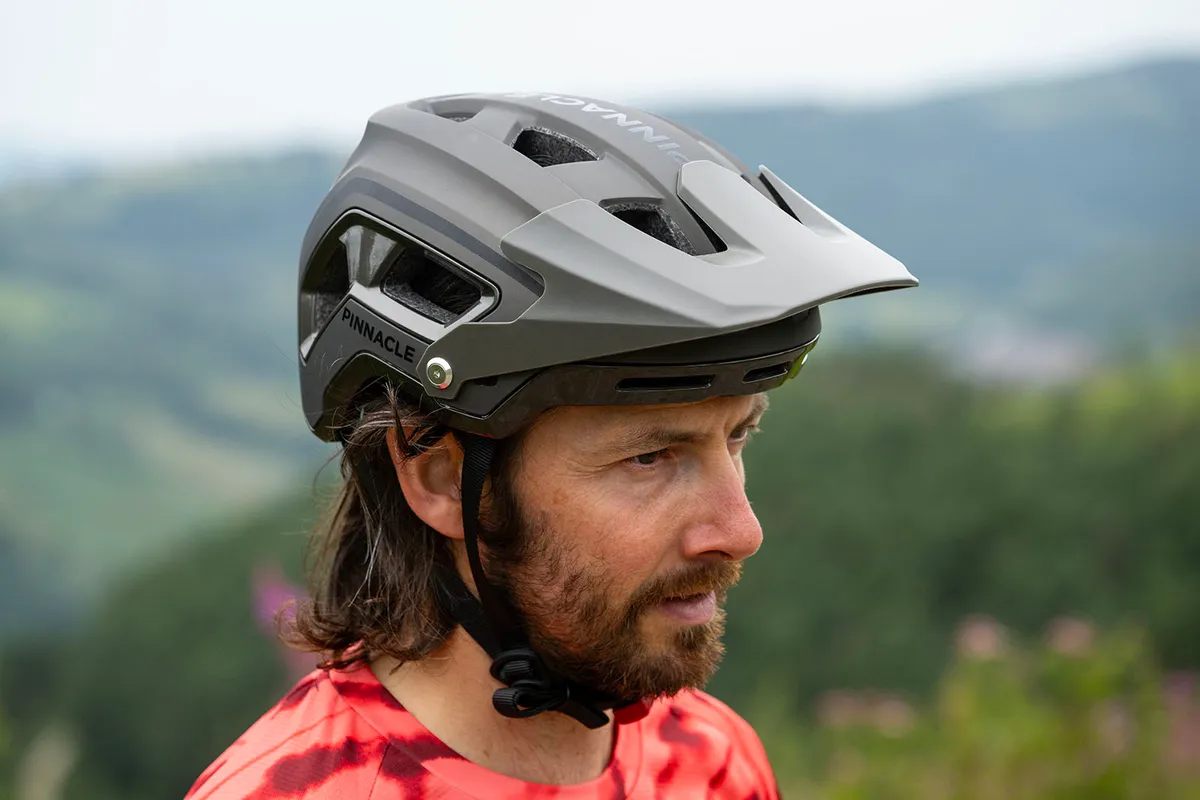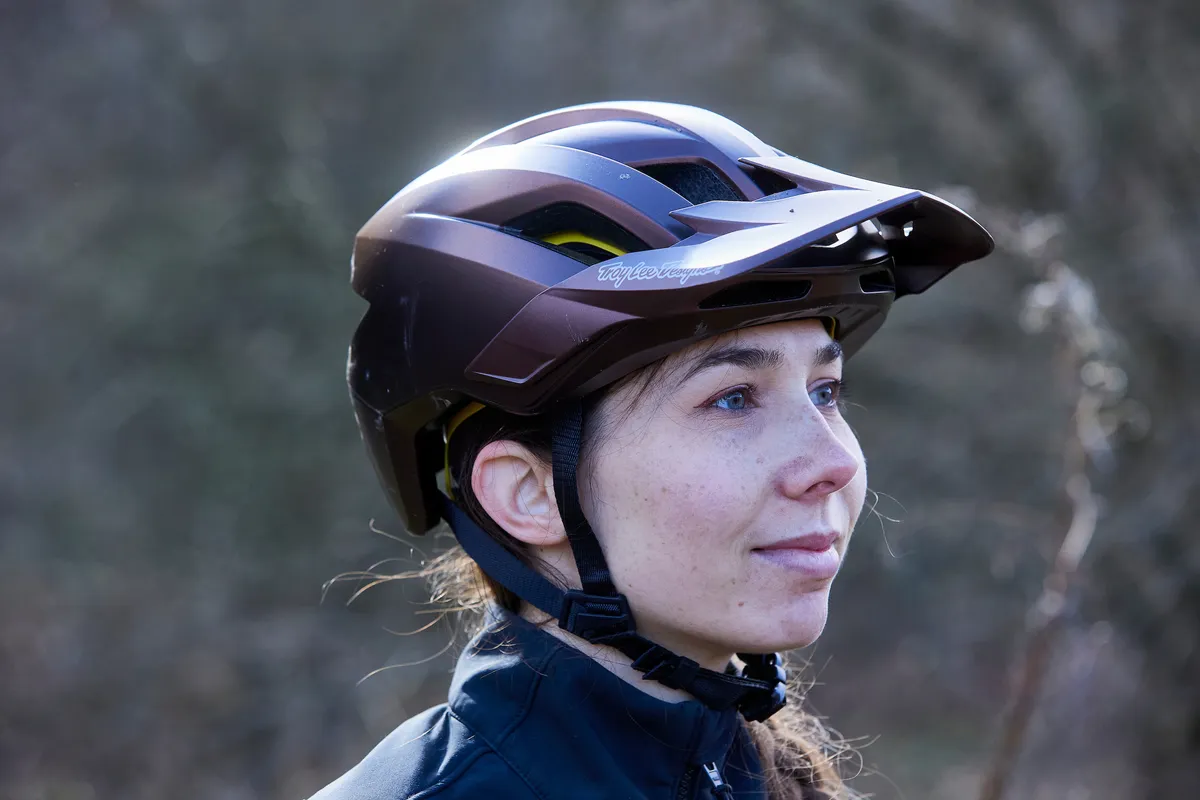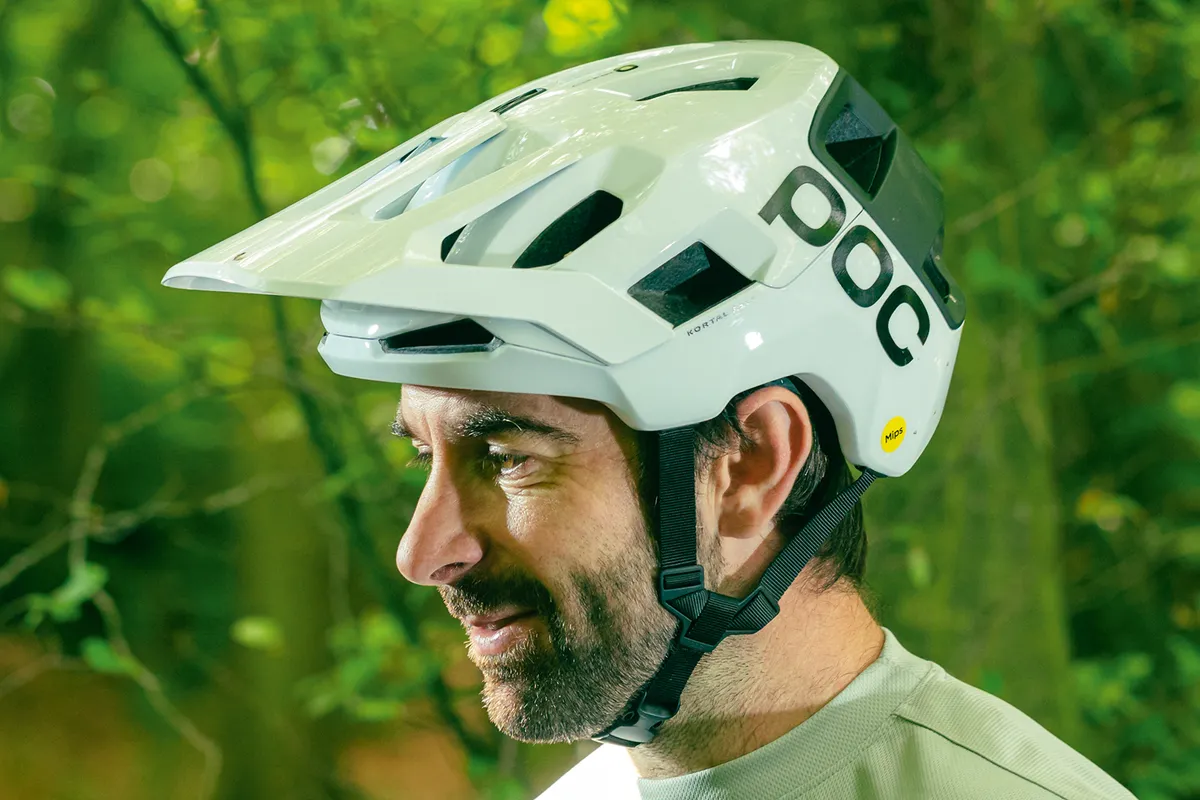Protecting your head is vital in the rough-and-tumble world of mountain biking, where crashes can be an all-too-frequent occurrence. That’s why getting the best mountain bike helmet possible is hugely important to staying safe and comfortable.
We’ve rounded up our pick of the best trail helmets currently on sale, plus our advice on what to look for when you’re buying a new lid.
We also have a list of the best enduro helmets and best full-face mountain bike helmets, and another looking at the best road helmets if you ride on tarmac.
Editor's note: this list was updated on 1 April 2025 with our latest top-rated helmet reviews.
Best mountain bike helmets 2025, as rated by our expert testers
Fox Speedframe Pro
SQUIRREL_TEXT_13083226

- £149.99 / $169.95 / €159.99 / AU$199.99 as tested
- Pros: Comfortable and ventilated; MIPS-equipped; sharp looks
- Cons: Not compatible with medium- and large-sized goggles
The Fox Speedframe Pro is a comfy and airy helmet that was near-perfect in our testing and received full marks from independent safety assessors.
The adjustable peak wards off the sun and should fit most types of goggles (on or off the face) without causing them to steam up.
Both straps and buckles are easy to tighten and undo one-handed. The sole issue is the lack of a crash-replacement policy.
SQUIRREL_13083226
Pinnacle MTB Helmet
SQUIRREL_TEXT_13114245

- £70 as tested
- Pros: Modern styling; comfortable fit; plenty of adjustment
- Cons: Could be more breathable
The Pinnacle MTB Helmet features a dropped rear portion that protects the back of your head and works well for trail riding.
We found the ventilation to be a little weak for full-blown cross-country outings, with the 22 vents too small to allow hot air out in summer months.
The helmet works well with most glasses, bar some more modern super-wide frames, which cause some interference.
Despite the budget price, the Pinnacle MTB helmet is well-built and good quality.
- Read more: Pinnacle MTB Helmet review
SQUIRREL_13114245
Troy Lee Designs Flowline MIPS helmet
SQUIRREL_TEXT_13076958

- £100 as tested
- Pros: Impressive comfort and fit; sleek style at a great price
- Cons: MIPS liner can be a bit noisy
A sharp and sleek design makes this helmet a lot less bulky than others, and the well-placed padding ensures the Flowline is comfortable on long rides.
The ventilation works well, with our tester finding the removable pads worked well in soaking up sweat.
The Flowline is compatible with many riding glasses, with the helmet's straps sitting comfortably over their arms and space under the peak to store them.
- Read more: Troy Lee Designs Flowline MIPS helmet review
SQUIRREL_13076958
Bell Super Air Spherical
SQUIRREL_TEXT_13089507

- £224.95 as tested
- Pros: Top-tier comfort levels; premium build quality
- Cons: Peak needs some refinement
The Bell Super Air Spherical uses two layers of EPS foam for impact protection, with the outer layer being denser to take the sting out of high-speed impacts.
Our tester found the Ionic+ padding and 360-degree retention system kept the helmet comfy on long days out.
With 17 vents, the helmet also works well at cooling your head – though not all vents penetrate through the inner EPS layer.
The helmet can be converted into a lightweight full-face helmet with the purchase of an £89.99 chin bar.
- Read more: Bell Super Air Spherical review
SQUIRREL_13089507
Fox Dropframe Pro
SQUIRREL_TEXT_13088680

- £270 / $280 / €280 / AU$400
- Pros: Comfortable; good adjustability; decent ventilation; great coverage
- Cons: Glasses compatibility; pricey
While it's on the expensive side, the Dropframe Pro makes no concessions for comfort, with the helmet featuring plenty of easy-to-use adjustability.
There's also plenty of ventilation, with the rear portion of the helmet featuring numerous exhaust vents enabling air to rush through.
We found the helmet to cause compatibility issues with some glasses, but the extra protection adds extra confidence on the trial compared to other trail helmets.
- Read more: Fox Dropframe Pro Helmet review
SQUIRREL_13088680
Fox Speedframe RS
SQUIRREL_TEXT_13201221

- £225 / $280 / €250
- Pros: Top-rated safety ranking; good venting; comfy
- Cons: Retention cradle wire becomes noticeable after a while; not the easiest glasses storage
Fox's Speedframe RS boasts an impressive rating in Virginia Tech's Safety rankings, although this protection comes at a serious cost.
We found the helmet offered good breathability, although overall comfort was compromised by the retention cradle wire at the rear of the helmet.
Apart from this, the helmet offers an airy feel thanks to large vents on the front and rear.
The glasses storage feature is a useful addition, although it wasn't the easiest to use.
- Read more: Fox Speedframe RS review
SQUIRREL_13201221
Giant Rail Helmet
SQUIRREL_TEXT_13093023

- £150 / $190 / €150 as tested
- Pros: Slick design; good ventilation; high levels of adjustability
- Cons: Round shape may cause pressure points; slim lining doesn't offer much cushioning.
Giant's Rail Helmet delivers plenty of safety tech, with the MIPS protective liner, and great breathability thanks to the large and plentiful vents.
The three-position adjuster makes finding the right fit easy, though our tester found the rounded shape caused some discomfort on longer riders.
The Rail's glasses compatibility is well-designed, and they can be stored under the visor when not in use.
- Read more: Giant Rail Helmet review
SQUIRREL_13093023
Mavic Deemax MIPS
SQUIRREL_TEXT_13122340

- £149 / $156 / €149 as tested
- Pros: Decent ventilation; good protection; comfortable
- Cons: Visor position not very effective; glasses stowage not the best
The Deemax MIPS ticks a lot of boxes for a trail/enduro helmet, with good ventilation and high levels of comfort making it seemingly disappear when worn.
The MIPS lining adds another level of protection compared to some rivals, and the shape of the helmet is up-to-date.
We didn't find the visor well-positioned, voiding its purpose. Glasses stowage was also lacklustre and not the most secure.
- Read more: Mavic Deemax MIPs review
SQUIRREL_13122340
Oakley DRT5
SQUIRREL_TEXT_13158113

- £170 / $200 / €200 / AU$265
- Pros: Comfort; good ventilation
- Cons: High weight and price
- Claimed weight: 471g (unspecified size)
The Oakley DRT5 may look plain, with a sole pad to cushion the back of your head and only a silicone seal for your forehead.
However, it's extremely comfy and the absence of bulky padding reduces risk of overheating. Should you warm up, the seal also prevents sweat dripping down your face.
This performance comes with a weight and price penalty, but Oakley does offer 50 per cent off replacements within three years of the original purchase.
- Read more: Oakley DRT5 review
SQUIRREL_13158113
POC Kortal Race MIPS
SQUIRREL_TEXT_13084103

- £220 / $250 / €250 / AU$400 as tested
- Pros: Plenty of coverage and decent venting
- Cons: Pricey
- Actual weight: 407g (Medium)
The POC Kortal Race MIPS is a pricey helmet, but POC has managed to pack in lots of features and safety tech, which makes it an attractive package.
The helmet features MIPS technology and has plenty of coverage to keep your head protected. There is also a chip in the helmet, which can store all your medical information if the worst does happen.
The retention system wraps around the whole head, which minimises the chance of any hot spots, and overall we found the Kortal Race comfortable to wear.
The venting in the helmet does a good job of circulating air around your head on warm days.
- Read more: POC Kortal Race MIPS review
SQUIRREL_13084103
How we test mountain bike helmets

We test mountain bike helmets out on the trails to see how they perform in their natural terrain.
Our expert mountain bike testers have reviewed hundreds of helmets over the years, so know exactly what strengths and weaknesses to look out for.
Long test cycles are used to ensure reviews are reflective of ownership.
Ultimately, our mountain bike helmet reviews are based on the following criteria:
- Comfort – is the helmet comfortable for long rides?
- Protection – does the helmet feature any additional protective features such as MIPS?
- Ventilation – are there enough vents to keep the helmet from overheating?
- Features – are there additional features such as glasses stowage?
- Value for money – is the helmet a good deal compared to others on the market?
Why you can trust BikeRadar
BikeRadar has been an authority on bikes and cycling tech since its inception in 2007, delivering the world’s best riding advice.
We have experts testing all types of bikes, parts, clothing and accessories, from road, mountain and gravel bikes to commuting, bikepacking and electric bikes.
Our reviews are always editorially independent – with no exceptions. Our reviewers comprehensively test all products in the real world, always reflecting on performance, value and the wider market when delivering their verdicts and review ratings.
We have more than 15,000 product reviews available at your fingertips, as well as expert buying, maintenance, training, skills, health and fitness advice.
Our annual Bike of the Year test is an industry benchmark and the BikeRadar team consists of some of the most experienced riders and testers in the business.
Mountain bike helmet buying advice
The best mountain bike trail helmets manage to balance the often-competing needs of protection, ventilation, comfort and weight.
Protection

Helped by the rise in popularity of enduro racing, many open-face lids now offer greater coverage around the back of the head and the temples than cross-country or road-style helmets, helping to boost protection.
Unless you care about every single gram or really want ultimate cooling, that makes them a sensible bet for the majority of riders.
Most bike helmets use some form of expanded polystyrene, or EPS foam, formed around a core of another, tougher material to provide cushioning in the event of an impact.
The foam crushes when it’s struck, spreading and delaying the force of the impact being transmitted to the wearer, hopefully to a level that will prevent injury.
While the impact resistance of helmets is covered by a number of test standards to ensure they perform when they’re needed, manufacturers have been introducing extra technology to try to improve on this.
One such technology is MIPS (multi-directional impact protection system), which uses a floating plastic liner between the head and the EPS structure, which reduces the amount of rotational force transmitted to the brain during a crash.
Rotational force is responsible for a large number of injuries, including brain damage, so while it makes manufacturing, and thus retail, prices more expensive, many manufacturers now incorporate MIPS into their helmets.
Most bicycle helmets now have a hard plastic outer moulded to the EPS structure. This is known as in-moulding and provides protection against minor bumps and scratches that would otherwise damage the EPS.
On cheaper helmets, this tends to be limited to the top and sides of the helmet. More expensive, fully in-moulded helmets extend the plastic protection down and around the rim, making it much more effective at fending off damage.
Ventilation

While the extra coverage of trail-style helmets is more than welcome, it does get in the way of airflow, which can mean a much warmer and sweatier head in hot weather or when you’re pushing really hard.
Happily, thanks to the increasingly clever use of materials and design, it’s now possible to make a lid that’s almost as cool as a conventional design.
Having lots of vents is important, but it’s the internal channels that help airflow in through the front, over the head and out the back that makes all the difference.
Look for big vents on the front and rear, with deep channels on the inside of the lid.
Comfort
How well a helmet fits will depend on the size and shape of your head. Many people tend to get on with certain brands that use a particular shape, but finding the right one is very much a case of trial and error.
If possible, go to your local bike shop to see how you get on with different lids or ask your friends if you can try theirs.
The main thing is to ensure you can get the helmet sitting securely on your head so there are no pressure points or undue movement.
Most helmets will have a retention system of some kind to allow you to adjust how tightly it fits onto your head. Many of these will tighten and loosen around the circumference of the head, although some also adjust in other ways.

However it works, make sure you can operate the system easily in gloves and that it doesn’t trap hair or pinch flesh.
Also ensure that you can adjust the straps to get a solid fit that’s not restrictive and that when fully adjusted you have a clear, unobstructed view, especially when you’re in an aggressive, head-down riding position.
Check that the peak can be adjusted so that it keeps the sun out of your eyes without getting in the way or flapping about when you ride. If you like to ride wearing sunglasses for mountain biking, make sure they fit comfortably with the lid.
Weight
While weight might seem like a minor consideration compared with a helmet's other characteristics, a lightweight helmet will be a much more pleasant place to be after a long day on the bike.
A light lid is much less likely to move about as you ride, too.
Convertibility

A number of helmets on the market now come with a chin guard that can be removed. This is largely in response to the growth in enduro racing, where long climbs benefit from an open-face lid to help you breathe and stay cool, while gnarly descents mean the additional protection from a full-face-style lid is desirable.
With a removable chin guard, riders get the best of both worlds.
The compromise is often weight because, if the helmet has full ASTM downhill certification (so it can be used as a DH race helmet), there needs to be extra protection built in. Not all of the convertible helmets meet this standard, though.
Whether you choose a convertible helmet is up to you, but we're definitely seeing more on the trails these days.
Anything else I might need to know?
If you love to record and share your rides online, then you’ll be pleased to know that more and more manufacturers are integrating removable camera mounts into their helmets.
These allow a secure fitting for your camera, but also mean you can go back to having an unfettered helmet when you want to.
Many enduro-style lids also enable you to use goggles to provide almost impregnable eye protection. Look for helmets with a peak that lifts up high enough for you to be able to fit the goggles underneath and a strap of some kind at the back to keep them secure.
Be sure to check out our pick of the best mountain bike goggles for more.




